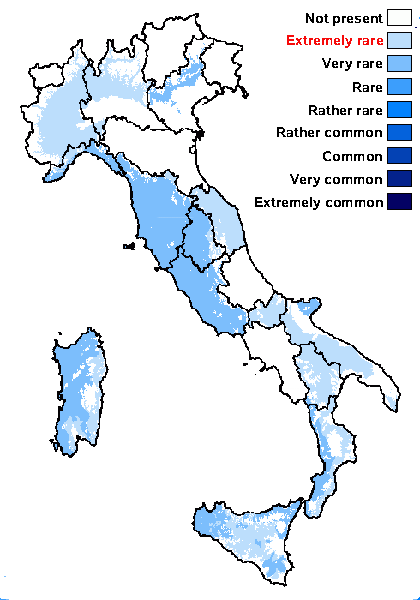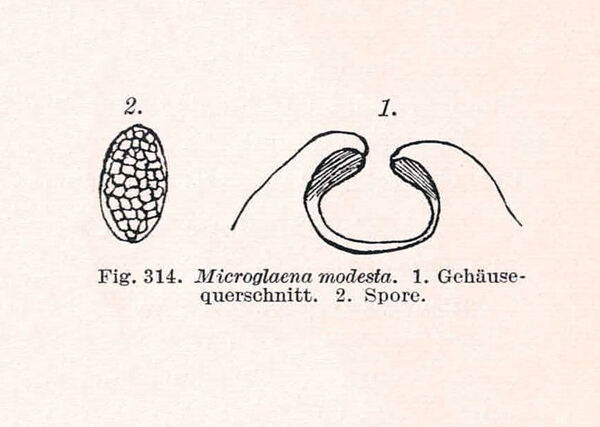Thelenella modesta (Nyl.) Nyl.
Mém. Soc. Sc. Nat. Cherbourg, 3: 193, 1855. Basionym: Verrucaria modesta Nyl. - Bot. Not.: 164, 1853.
Synonyms: Dactyloblastus wallrothianus (Körb.) A. Massal.; Luykenia modesta (Nyl.) Trevis.; Microglaena modesta (Nyl.) A.L. Sm.; Microglaena subcorallina Hasse; Microglaena wallrothiana Körb.; Microglaena wallrothiana var. septentrionalis Th. Fr.; Phlyctis norvegica Norman; Polyblastia modesta (Nyl.) H. Olivier; Thelenella wallrothiana (Körb.) Syd.; Verrucaria sericea var. wallrothiana (Körb.) Garov.
Distribution: N - Ven, Lomb, Piem (Caniglia & al. 1992), Lig (Valcuvia & al. 2000). C - Tosc, Marc (Candotto & al. 2013c), Umb (Ravera 1998, Ravera & al. 2006), Laz (Ravera 2001), Mol (Nimis & Tretiach 1999, Caporale & al. 2008, Caporale & Ravera 2020), Sar. S - Pugl (Nimis & Tretiach 1999), Bas (Potenza & al. 2014), Cal (Puntillo 1996, Puntillo & Puntillo 2004), Si (Nimis & al. 1994, Grillo & Cristaudo 1995, Grillo & Carfì 1997, Grillo 1998, Grillo & Caniglia 2004, Ottonello & Puntillo 2009, Ottonello & al. 2011).
Description: Thallus crustose, episubstratic, thin and membranous to thick and uneven-warted, yellow-grey, greyish brown, or brownish. Perithecia 0.3-0.5 mm across, globose, discrete or more or less aggregated, three-quarters to fully immersed in prominent thalline warts. Exciple dark brown near the ostiole, brownish in upper part, pale or colourless in lower part; paraphysoids delicate, 1-1.5 μm thick, branched and/or anastomosing; hymenial gel I-, K/I-. Asci 4–8-spored, fissitunicate, with two functional wall-layers, the inner wall thin and the outer thick, with an ocular chamber, I-. Ascospores muriform, with 6-10 transverse septa and 2-3 longitudinal septa, hyaline to very pale brown at maturity, ellipsoid to ellipsoid-elongate, (20-)25-42 x (9-)11-17 μm, the outer wall scarcely thicker than the septa. Pycnidia black, Roccella-type. Conidia simple, hyaline, thread-like, 11-14 μm long. Photobiont chlorococcoid, the algal cells without a gelatinous sheath. Spot tests: K-, C-, KC-, P-, UV-. Chemistry: without lichen substances.
Note: a mainly mild-temperate, western lichen found on bark of broad-leaved trees and shrubs in rather sheltered and humid situations; mostly Tyrrhenian in Italy. Some earlier records from Southern Italy could refer to the strictly Mediterranean Th. melanospora. It is included in the Italian red list of epiphytic lichens as “Near-threatened” (Nascimbene & al. 2013c).
Growth form: Crustose
Substrata: bark
Photobiont: green algae other than Trentepohlia
Reproductive strategy: mainly sexual
Most common in areas with a humid-warm climate (e.g. most of Tyrrenian Italy)
Commonnes-rarity: (info)
Alpine belt: absent
Subalpine belt: absent
Oromediterranean belt: absent
Montane belt: absent
Submediterranean belt: extremely rare
Padanian area: absent
Humid submediterranean belt: very rare
Humid mediterranean belt: very rare
Dry mediterranean belt: absent

Predictive model
Herbarium samples
Growth form: Crustose
Substrata: bark
Photobiont: green algae other than Trentepohlia
Reproductive strategy: mainly sexual
Most common in areas with a humid-warm climate (e.g. most of Tyrrenian Italy)
Commonnes-rarity: (info)
Alpine belt: absent
Subalpine belt: absent
Oromediterranean belt: absent
Montane belt: absent
Submediterranean belt: extremely rare
Padanian area: absent
Humid submediterranean belt: very rare
Humid mediterranean belt: very rare
Dry mediterranean belt: absent

Predictive model
| Herbarium samples |
 Index Fungorum
Index Fungorum
 GBIF
GBIF





